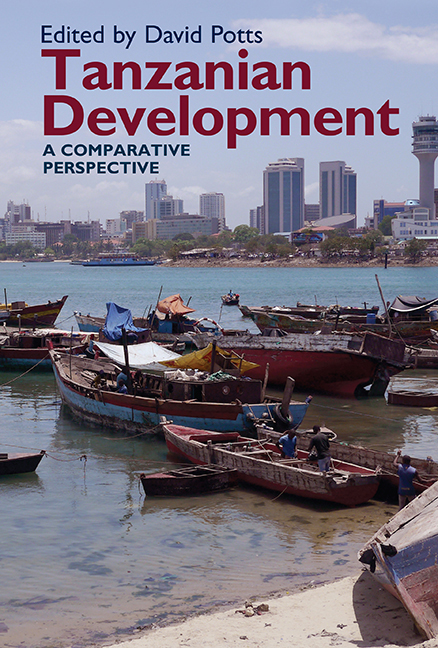Book contents
- Frontmatter
- Contents
- List of Illustrations
- Contributors
- Acknowledgements
- 1 Introduction – Tanzanian Development: A Comparative Perspective
- 2 The Political Economy of Tanzania 1967–2017: Reimagining the State
- 3 Reflections on the Tanzanian Trajectory: Decline and Recovery
- 4 Agricultural Development in Tanzania
- 5 Assets and Poverty Dynamics: The Methodological Challenges of Constructing Longitudinal Surveys in Tanzania
- 6 Contract Farming in Tanzania: Experiences from Tobacco and Sunflower
- 7 ‘We Just Sell Water – That is All We Do’: Two Cases of Small-scale Irrigation in Tanzania
- 8 The Industrial Development of Tanzania in Comparative African Perspective
- 9 Competitiveness in African Manufacturing: Some Evidence from Tanzania
- 10 ‘Good Life Never Comes Like Dreams’: Youth, Poverty and Employment in Arusha
- 11 International Aid to Tanzania – with some comparisons from Ghana and Uganda
- 12 Real Exchange Rate Changes and Export Performance in Tanzania and Ethiopia
- 13 Economic Leakage as a Constraint on Tourism's Effective Contribution to Local Economic Development in Tanzania
- 14 Extractive Industry Revenues and their Expenditure in Local Government Authorities: The Case of the Gold Service Levy in Geita District Council in Tanzania
- 15 Conclusion
- References
- Index
15 - Conclusion
Published online by Cambridge University Press: 24 October 2019
- Frontmatter
- Contents
- List of Illustrations
- Contributors
- Acknowledgements
- 1 Introduction – Tanzanian Development: A Comparative Perspective
- 2 The Political Economy of Tanzania 1967–2017: Reimagining the State
- 3 Reflections on the Tanzanian Trajectory: Decline and Recovery
- 4 Agricultural Development in Tanzania
- 5 Assets and Poverty Dynamics: The Methodological Challenges of Constructing Longitudinal Surveys in Tanzania
- 6 Contract Farming in Tanzania: Experiences from Tobacco and Sunflower
- 7 ‘We Just Sell Water – That is All We Do’: Two Cases of Small-scale Irrigation in Tanzania
- 8 The Industrial Development of Tanzania in Comparative African Perspective
- 9 Competitiveness in African Manufacturing: Some Evidence from Tanzania
- 10 ‘Good Life Never Comes Like Dreams’: Youth, Poverty and Employment in Arusha
- 11 International Aid to Tanzania – with some comparisons from Ghana and Uganda
- 12 Real Exchange Rate Changes and Export Performance in Tanzania and Ethiopia
- 13 Economic Leakage as a Constraint on Tourism's Effective Contribution to Local Economic Development in Tanzania
- 14 Extractive Industry Revenues and their Expenditure in Local Government Authorities: The Case of the Gold Service Levy in Geita District Council in Tanzania
- 15 Conclusion
- References
- Index
Summary
Tanzania is changing continuously. Much has been learnt but the need for further research always remains. This book has raised a lot of questions, and I hope it has provided some answers, as well as restated some important lessons. This conclusion draws together some of the main issues and arguments, and provides some pointers towards future research.
There are around five times as many people in Tanzania as there were at independence, and their average income is about double the value at independence. At independence only just over 5 per cent of the population were living in the urban areas. By 2016 this had increased to over 32 per cent. Inequality has increased slightly, but the poorest 10 per cent have experienced similar percentage increases in income to the richest group. However, the second, third and fourth deciles have fared worse, suggesting some increase in relative poverty. The contribution of agriculture to GDP declined fairly steadily until 2007, but it has not changed much since then. Adult literacy has increased steadily until recently, and the gender gap has decreased significantly. Life expectancy has increased steadily, and is now 50 per cent greater than at independence.
Tanzania still retains some of the appearance of a parliamentary democracy and so far competitive elections have always taken place, albeit in a media context that favours the ruling party. However, there are increasing concerns about irregularities in the conduct of elections, intolerance of political dissent, suppression of the media and the treatment of minorities such as the LGBT community. The reputation of Tanzania as a reasonably fair, tolerant and open society is at risk if some of the current trends are allowed to continue.
Chapters 2 and 3 concur in many respects on the issues facing Tanzania, although they arrive at their conclusions by different approaches. Their key conclusions relate to the fairness of distributional outcomes, the closely related issue of corruption and the potential dangers of arbitrary measures taken by an authoritarian government. However, official justification of such measures to the public may be dressed up as measures to counter corruption. Is it too much to hope that the government could respond to public concerns about corruption without intimidation of political opponents?
- Type
- Chapter
- Information
- Tanzanian DevelopmentA Comparative Perspective, pp. 289 - 292Publisher: Boydell & BrewerPrint publication year: 2019

